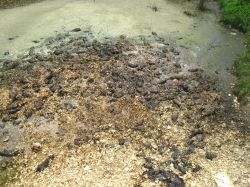Pollution
on the Tusket
Tricounty Watershed Protection Association
Compost
by G.J.LeBlanc
Return to Home Page
UNDER CONSTRUCTIONTricounty Watershed Protection Association
Compost
by G.J.LeBlanc
Return to Home Page
| COMPOSTING: What
it does and does not do. |
||
 The cheapest way to process manure is to just dump it anywhere. This is what happened and is why we have this situation in the South West Nova river systems. The temptation would be to continue this practice even if it is not as blatantly obvious as in the picture on the right. However regulators, farmers and you and I have to get involved. This cannot be allowed to happen. Composting does not remove phosphates from manure (Fecal & Urine). Since mink food is fortified with phosphates (phosphoric acid) mink manure contains about 10 times more K that of most other manures. What escapes from the dung pile is Nitrogen (N2) and Methane (CH4), water vapour & aromatic hydrocarbons . The pile can loose as much as 50% of its weignt but still contains relatively the same amount of nutrients as before. You could cremate it and get rid of all the water and carbon but you would still have most of the nutrients and in a very water soluble state. You can use it to generate power by collecting the methane but what is left is still manure. Even if you could make compost suitable for "consumption" it would still be just as toxic to aquatic systems. If it is buried in the ground it will eventually find it's way into the watershed and rivers. It is a valuable but dangerous substance and must be handled with respect, for what it can potentially do, for good or bad.
Chemical fertilizer such as 6,10, 10. Nutrients: Nitrogen, Phosphorus, Potassium Effect: Chemical fertilizers: leach away into our ground water without fully benefiting the plant. Chemical fertilizers, because of their acidity, kill the “great aerators” of the soil. Chemical fertilizers encourage plant disease. Chemical fertilizers produce fruits and vegetables with lower nutritional value and less flavor. (1) Manure is a mix of inorganic nutrients within a matrix of organic matter. Nature is very compatible with this form of nutrition. Nutrients: Nitrogen, Phosphorus, Potassium. PLUS: micro-nutrients such as Calcium, Magnesium, Sulfur, Iron, Boron, Copper, Manganese, Zinc etc. Managing manure: On one hand, manure can nurture life, on the other it can destroy life. Ultimately the man with his hands on the shovel will decide, or is it the man with his hands, on the hands of the man with the shovel.. There must be someone out there with enough brains to make money off this stuff and keep it out of the rivers. Did you know ? That the worlds phosphorus supplies are running low. |
||
| What does off-site
disposal mean?... Safely using manure as a fertilizer 1. Composting dangers 2. Controlled soil injection. |
||
===================================================================================
| Storage: |
|
| Earthen pits :http://extension.missouri.edu/p/WQ305
|
|
If not properly managed,
agricultural activity can release high levels of
fertilizers and pesticides into a lake. Runoff from
manure piles and silage pits may also make its way
into a lake. Herbicides commonly used in farming
operations can suppress production and growth of many
aquatic plants and organisms. High levels of nitrogen
and phosphorus, found in fertilizers, can cause
massive blooms of plankton and aquatic plants. As
these organisms die and decompose, they use oxygen in
the water, reducing the oxygen available for fish and
plants. A habitat is the natural home of a plant
or animal. Changes to this home will affect the
organisms that live there - sometimes in harmful ways.
http://www.gov.ns.ca/agri/4h/manuals/fisheries/unit2.pdf |
|
| 1.http://www.monroeworks.com/articles/organic-fertilizers-vs-chemical-fertilizers.htm |
|